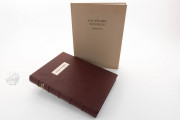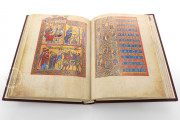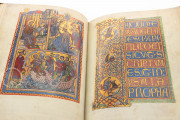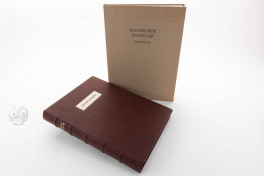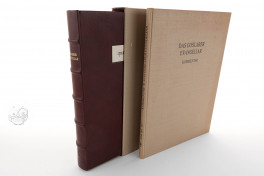A spectacular manuscript of the early German Gothic, the Goslar Gospels contains thirty full-page illuminations all brightly colored with gilded backgrounds within its original gold-encrusted cover. It was created in the central German city of Goslar for the Neuwerk cloister for women.
Its images combine an older Byzantine tradition with aspects of the newer Gothic mode out of France and reinforce ideas of orthodoxy, tradition, and obedience. In this way, the lavish manuscript strengthened the bonds between the monastic foundation and Rome under its new provost, Johannes, after a period of heresy and inquisition.
The Gospel texts are written in Latin in a precise Gothic textura in long lines on heavily ruled parchment pages. Elaborately ornate incipit pages introduce each Gospel with an enlarged decorated initial and golden, pen-flourished uncials on alternating blue and red bands. Two dozen additional images illustrate the evangelists and biblical events.
The result is a manuscript of exceptional quality and beauty that announces the wealth and power of the Church in Goslar and at once looks backward and forward during a time of reformations and change in medieval Germany.
Byzantine Iconography with Gothic Style
The illuminations in the Goslar Gospels reflect the multitude of artistic influences in early thirteenth-century central Germany. The overall iconography looks to the orthodox tradition of Byzantine and Ottonian art while aspects like the Gothic textura script, elaborate pen flourishes trailing off minor initials, and the alternating blue and red bands of golden text on the initial pages reflect the French Gothic. This marriage of old and new makes for an incredible manuscript, one that played a role in medieval monastic reformation.
A Gilded Gospel for Nuns
The Goslar Gospels was created in the aftermath of the inquisition for heresy and execution of Goslar’s bishop in 1224. The new provost, Johannes, brought new prosperity to the Neuwerk cloister. Reinforcement of orthodoxy, obedience, and submission are central themes to the gilded illuminations throughout the individual books of the Gospels.
The iconography throughout is based strongly on Byzantine models with French and English Gothic influences. The exquisite details, rich colors, gold backgrounds, and superlative script announce the new wealth of the foundation and reaffirms the superlative position of the scriptorium of the German monastery.
The crowning glory of this marvelous manuscript is its treasure cover. Gold filigree sparkling with pearls and colored stones surrounds a central crucifixion. Evangelist symbols fill the corners of the central panel, the iconography of which reflects the same Byzantine tradition as the inner illuminations. Enamel panels may have filled the now-empty spaces in the filigree frame. Two of the larger stones are Roman carnelian cameos.
The enthroned Madonna panel affixed centrally below the crucifixion is a copy of the provost seal of the Neuwerk cloister, reaffirming the manuscript’s ownership. The back cover is a heavily damaged silk embroidery that may have been crafted by the nuns at Neuwerk. The text block was rebound in 1878.
We have 1 facsimile edition of the manuscript "Goslar Gospels": Das Goslarer Evangeliar facsimile edition, published by Akademische Druck- u. Verlagsanstalt (ADEVA), 1990
Request Info / Price


